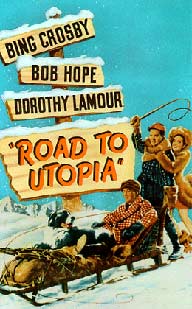|
LITR 5439 Literary & Historical Utopias |
|
Amy Sasser
Looking Back to Moving Forward
In an effort to induce deeper levels of
understanding of “utopia” and its myriad of offshoots (dystopia, ecotopias,
communes, intentional communities, etc.), I looked back and reviewed some of the
work of the most recent seminar, conducted in 2011.
I selected three midterm assignments to work from, and I found quite a
bit of guidance. I digested some
best practices, took warning from some which didn’t work so well, and increased
my own comprehension of this literary genre through this small bit of research.
In searching for ideas and approaches that
seemed to work well for previous students, I found at least one stellar example
in each essay. In “The Attraction
of Perfection,” Chrissie Johnston begins with a short, but insightful and
interesting hook that is well-written and easy to understand.
This draws her reader in and invites them to come along on the journey
she describes in the remainder of her essay.
She speaks of the difficulty in defining utopia from a literary
perspective because “Getting a group of people to totally
agree on something is not easy, and when someone does not agree, . . . [when]
they do not believe a perfect society is possible, or if it is not their idea of
perfection, it is not a utopia and they stop reading.”
She then turns the tables and speaks to man’s insatiable curiosity, thus
extending her definition of “utopia” and tying into Objective 1a for the course.
Similarly, Omar Syed, in his essay “Utopias are Scarier than Dystopias,”
approached the assignment as a journey. His
ideas were both sound and well-supported, and he argued that the utopian novels
espouse a sort of one-sided soliloquy, while dystopian novels create a dialog
within the conflict of opposing world views.
My third choice to review was Nicole Wheatley’s “The Hypocritical World
of Utopias.” As with both my
previous choices, what drew my interest was the title:
clear and easy to understand with the promise of something interesting to
follow. One sentence from
Wheatley’s essay which immediately grabbed my attention was the concise
comparison, “Utopias are the dreams we look for.
Dystopias are the nightmares we try to escape. . . .”
She stuck well to her promised examination of hypocrisy, pointing out
that, “underneath the surface, utopias are the
ultimate tyranny, one man’s or woman’s way of imaging [sic] society as it should
be, with no other options or alternatives.”
Each of these essays, however, also had something that didn’t work out as
well, or that became a definite instruction of what
not to do.
Taking a secondary stroll through the
journeys with these scholars, I found some practices that I will attempt to
avoid. For example, about halfway
through Johnston’s essay, the tables turn a bit from journey of discovery to
more of a planned path of attack.
While knowing this intended application of her new knowledge is gratifying to
the reader, the turn seemed a bit abrupt and became much more personal in scope.
Additionally, she names some notable figures, but misspells one of their
names, and her typos and grammatical errors seem to increase in frequency
(though, overall, they remain minimal) near the end of her essay.
While reviewing Syed’s work, I found that
his near run-on sentences and
rambling lists of authors or titles tend to distract from his mission and leave
the reader stranded in a sea of words with no visible shoreline to save them.
The work made me dig for meaning hidden among the prose, often having to
read and re-read sentences to follow them.
The method lacked cohesion and coherence.
For example, in illustrating the point regarding soliloquy versus
dialog, he shoves the entire explanation into one sentence spanning four lines
and follows it with a long-winded example from
The Giver, before quoting an earlier
student, and returning again to his Giver
evidence. However, he doesn’t stop
there, as he then adds several other examples along with another quote which
does not stem from course texts or previous student work.
This point could have been well made with a bit of reorganization of
elements and some meticulous editing.
Switching gears to Wheatley’s work, despite the aforementioned
gems of seeming wisdom, I find
that her entire paper becomes suspect the moment she quotes Wikipedia as a
source and only sporadically uses quotation marks to indicate which words are
her own versus someone else’s throughout the paper.
Combined with the assumed universal definition of Heaven (not everyone
would agree that her assertions are their idea of Heaven), the improper
punctuation and grammar, and switching between tenses or first, second and third
person, this piece becomes a chore to read.
One sentence, even taken in context, quite literally gives me a headache:
[quotation indented]
These feeling are the direct and
desired results of leaders, a way for the leaders to minimize conflict and
maximize quality and harmony among the Utopians.
I
play on society by More using satire as the genre helping the give the novel
itself a plot. The utopian leaders “do [ing] everything they can to
bring these metals into contempt” (87) a hypocritical way of forcing citizens of
the society to believe something in order to bring them excess, and just
reinstating a utopian never survives without some form of greed. Just proving
utopian is a ruse, a joke, a hypocritical place where in the end human nature
always wins and evil prevails [emphasis mine].
[end quotation indent]
This example, therefore, becomes a primer in how not to
construct a midterm response. Once
again, some judicious editing and perhaps restructuring could have greatly
improved the overall quality of the piece.
Finally, I reviewed each work to see what new
insights it inspired in me or how it may have expanded knowledge gained within
the seminar or the readings. As a
writing teacher, I found that some of Johnston’s insights fit well within my own
experiences interacting with students.
She says, “Connecting characters to readers,
readers to characters, and therefore to social issues is what literature is all
about.” That is a well-said concept
that I will continue to consider both in my own writing and in my instruction in
the practice. Moving back into
Syed’s essay, I am again struck with his idea that utopia is one-sided and
dystopia is in itself a dialog. I
believe this idea could be further expanded with more time and research, as well
as used to help explain why today’s educational system tends to focus on
dystopian works exclusively.
Finally, in trying to find what take-aways I could amongst Wheatley’s words, I
focused on her discussion of duality, when she says (or perhaps quotes), “the
binary structure of language which produces an abundant network of paired terms
whose meanings are one another’s opposites – masculine/feminine, public/private,
good/evil – and so on. What is masculine is
not feminine, what is public cannot
be private.” It is intriguing to
consider what that means when faced with a one-gender society like that found in
Herland.
This process of reviewing and reporting on
previous students’ work has been quite enlightening as I face my own midterm.
I have found both good and bad in each of the examples I studied, and I
have expanded my own understanding of the topics paramount in the course
objectives. I found this
assignment, rather than being “another paper” or another writing chore, has been
a useful endeavor which I will consider in other classes and other work moving
forward.


